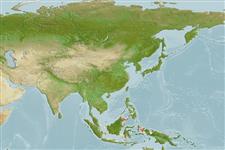Actinopterygii (ray-finned fishes) >
Perciformes (Perch-likes) >
Blenniidae (Combtooth blennies) > Blenniinae
Etymology: Meiacanthus: Greek, meion = less = lessen + Greek, akantha = thorn (Ref. 45335); vicinus: Specific epithet means 'near' or 'neighboring' referring to the presumed sister species relationship with M. geminatus.
Environment / Climate / Range
Ecology
Marine; demersal; depth range 1 - 10 m (Ref. 90102). Tropical, preferred ?
Western Central Pacific: known only from Indonesia.
Size / Weight / Age
Maturity: Lm ? range ? - ? cm
Max length : 4.1 cm SL male/unsexed; (Ref. 7401)
Short description
Morphology | Morphometrics
Dorsal
spines
(total): 4;
Dorsal
soft rays
(total): 26;
Anal
spines: 2;
Anal
soft rays: 15. White with a pair of black stripes on upper head and body, the dorsalmost extending onto basal portion of dorsal fin. Segmented caudal rays 11; in adult males, outer lobes of caudal fin moderately elongated; body depth about 4.6 in SL. Maximum size to 6.5 cm TL (Ref. 90102).
Adults are found in sheltered coastal, lagoon, and outer reefs in 1-10 m; solitary or in pairs (Ref. 90102). Collected from a depth of 10 m (Ref. 7401). Oviparous. Eggs are demersal and adhesive (Ref. 205), and are attached to the substrate via a filamentous, adhesive pad or pedestal (Ref. 94114). Larvae are planktonic, often found in shallow, coastal waters (Ref. 94114).
Life cycle and mating behavior
Maturity | Reproduction | Spawning | Eggs | Fecundity | Larvae
Oviparous, distinct pairing (Ref. 205).
Smith-Vaniz, W.F., 1987. The saber-toothed blennies, tribe Nemophini (Pisces: Bleniidae): an update. Proc. Acad. Nat. Sci. Philad. 139:1-52. (Ref. 7401)
IUCN Red List Status (Ref. 115185)
CITES (Ref. 94142)
Not Evaluated
Threat to humans
Harmless
Human uses
More information
Age/SizeGrowthLength-weightLength-lengthLength-frequenciesMorphometricsMorphologyLarvaeLarval dynamicsRecruitmentAbundance
ReferencesAquacultureAquaculture profileStrainsGeneticsAllele frequenciesHeritabilityDiseasesProcessingMass conversion
Tools
Special reports
Download XML
Internet sources
